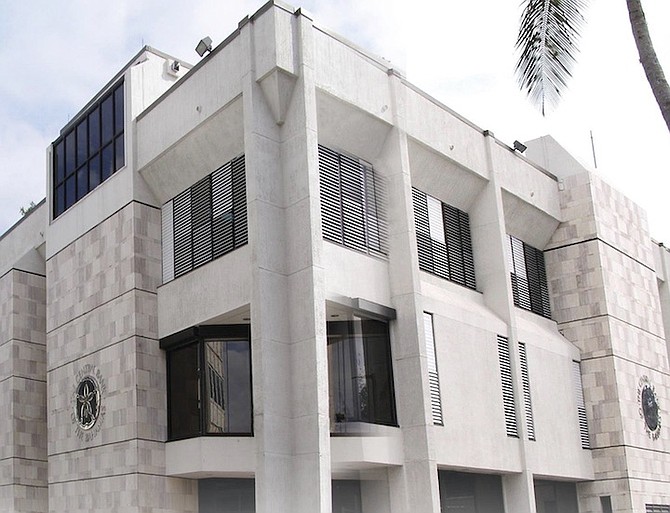By NEIL HARTNELL
Tribune Business Editor
nhartnell@tribunemedia.net
The Bahamas’ national debt enjoyed its first quarterly contraction for years during the three months to end-September 2022, the Central Bank revealed yesterday, although the decline was a modest $20.7m,
The regulator, unveiling its quarterly review for the 2022 third quarter, acknowledged that the decline was a relatively insignificant 0.2 percent when measured against the country’s total $11.167bn debt at end-September.
However, following the deficit and debt blow outs produced by the combination of Hurricane Dorian and COVID-19, which merely worsened pre-existing fiscal woes by adding more than $3bn to the national debt in three years, the modest shrinkage may yet provide some optimism that The Bahamas is starting to arrest the rate of ‘red ink’ growth.
The drop was produced by a $17.m quarter-over-quarter fall in the Government’s direct debt, while contingent liabilities that it has guaranteed on behalf of state-owned enterprises (SOEs) and other government agencies fell by a more modest $2.9m. This, though, came after a $679m debt increase over the 12 months to end-September 2022 as COVID’s revenue and spending impacts began to ease.
“The direct charge on the Government fell by $17.8m (0.2 percent) over the quarter, but rose by $688m (6.8 percent) year-over-year to $10.775bn at end-September 2022. An analysis by component showed that Bahamian dollar obligations represented 52.9 percent of the total, while foreign currency liabilities accounted for the remaining 47.1 percent,” the Central Bank said.
“The Government’s contingent liabilities declined by $2.9m (0.7 percent) over the previous quarter, and by $9.3m (2.3 percent) year-on-year to $392m. As a consequence, the national debt - inclusive of contingent liabilities - reduced by $20.7m (0.2 percent) over the three-month period, but increased by $678.8m (6.5 percent) vis- à-vis the preceding year to $11.167bn.”
The Central Bank also conceded that the reduction in The Bahamas’ debt-to-GDP ratios had been driven by expanded economic output, rather than debt reduction, as the economy continues to rebound and reflate following the COVID-19 pandemic.
“Given these developments and more a restored level of output, the direct charge as a fraction of GDP decreased by an estimated 8.8 percentage points on a yearly basis to 86.1 percent at end September. In addition, the national debt-to-GDP ratio declined to an estimated 89.3 percent from 98.7 percent a year earlier,” the regulator added.
“Public sector foreign currency debt contracted by $33.5m (0.6 percent) to $5.569bn during the third quarter, but rose by $516m (10.2 percent) relative to the same period last year. In particular, amortisation payments of $50.6m overshadowed new drawings of $47m.
“Additionally, there was a $29.9m decline in the debt stock resulting from exchange rate adjustments. A breakdown by components showed that the Government’s outstanding liabilities, which accounted for 91.2 percent of the total, fell by $26.9m (0.5 percent) to $5.079bn on a quarterly basis. In addition, the public corporations’ debt stock decreased by $6.6m (1.3 percent) to $490.6m,” the Central Bank continued.
“Relative to the same quarter of 2021, total foreign currency debt service payments grew by $3.2m (3.5 percent) to $95.3m, attributed to an $18.6m (30.3 percent) rise in the Government’s payments to $79.8m amid the annual increase in the stock of outstanding debt.
“In particular, amortisation payments rose by $6.5m (17.9 percent) to $43.1m and interest charges by $12m (48.7 percent) to $36.7m..... As a consequence of these developments, the Government’s debt service to revenue ratio stood at 12.2 percent, approximately 1.9 percentage points higher than in 2021. In contrast, the ratio of debt servicing against exports of goods and services reduced by 1.1 percentage points to 8.6 percent, reflecting the export sector’s recovery.”
Elsewhere, the Central Bank said private sector construction activity was “subdued” during the 2022 third quarter apart from those projects driven by foreign direct investment (FDI). “On the domestic side, total mortgage disbursements for new construction and repairs, as reported by banks, insurance companies and the Bahamas Mortgage Corporation, reduced by 2.8 percent ($0.6m) to $21.1m following a 3 percent decrease the previous year,” it added.
“Residential disbursements declined by 0.8 percent ($0.2m) to $21.1m, a reversal from a 1.1 percent increase in 2021. Moreover, there were no commercial disbursements during the third quarter following a $0.9m decrease a year earlier.
“Total mortgage commitments for new buildings and repairs, a forward-looking indicator of domestic activity, fell by 10 to 47, while the corresponding value increased by 32.3 percent to $16.4m. Disaggregated by loan category, the number of undisbursed approvals for residential commitments reduced by nine to 46. However, the associated value rose by $5.9m (56.5 percent) to $16.3m.”





Comments
Porcupine 1 year, 4 months ago
No talk about rising interest rates. No talk about a global recession. No talk about inflation. Only their chosen numbers and words like "subdued" to obfuscate the realities swirling around us. If you look at it another way, it is the Bahamas government vs. the Bahamian public. They're winning people. A New Day it is.
Alex_Charles 1 year, 4 months ago
Not sure the national debt has ever decreased at any point in my entire life.
birdiestrachan 1 year, 4 months ago
only 21 million it is a start in the right direction. Neil.
killemwitdakno 1 year, 4 months ago
Crypto hub could've have granted us enough to pay off the IMF and fend off their austerity.
Commenting has been disabled for this item.